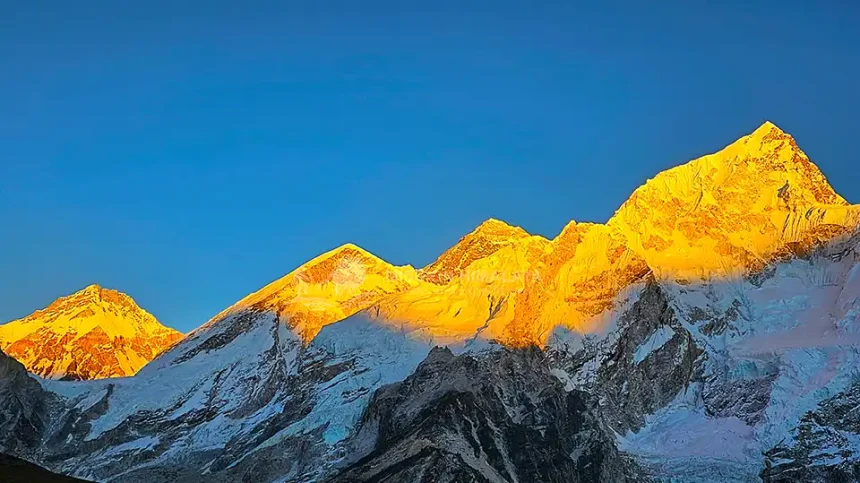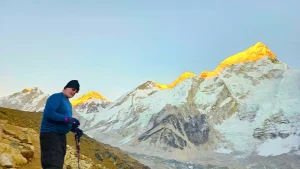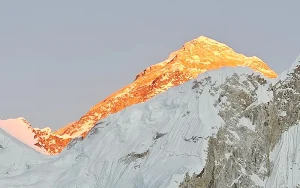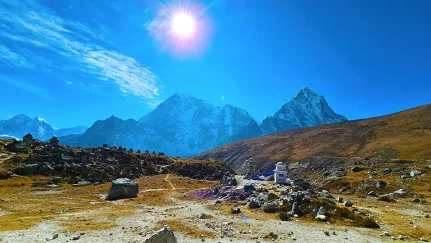How big is Mount Everest?
Well, everybody knows that Mount Everest is the tallest mountain in the world. Many people are also aware of where this tallest mountain in the world is located. For those who do not know, it is situated in the Mahalangur Himalayan range and expands between two territories of Nepal and Tibet and is ready for the trek or climbing expedition.
Being the tallest mountain in the world makes it the tallest natural skyscraper. But those who haven’t seen the mountain must be thinking how big is Mount Everest? Well, to know if it is big or not, we have to consider its base along with its height. If we have to think practically, we often realize that being tall is not only the reason to look big. As you know, Mount Everest has a height of 8848m from the sea level. But have you ever imagined how wide is it? I think you haven’t. You just have the picture of Mount Everest in your mind that has been taken from the front of the mountain.
We want to let you know that the base of Mount Everest is quite wide. The total distance covered by the Mountain is 12 miles (19.3 km), whereas the area of the top is 1.5 miles (2.4 km). Looking from the far sight, you will see the summit-like point, but it is more than just a point. Therefore, considering the wideness and the height of the Mountain you can finally say that Mount Everest is not just only tall, but it’s big too.
Now that you have a picture of how big Mount Everest is, it’s time to know how this big mountain range was formed. Keep patience and read forward-
How was Everest formed?
Mount Everest did not exist on this planet millions of years ago. So, you might be wondering how this big Mountain came out of nowhere. First, to understand how Mount Everest formed, we have to go 250 million years back. In this period, there were no continents and all of the continents were in the same land. Today we term that land as Pangea.
As time passed by, a three-pronged fissure occurred which separated the land and created the present-day continents known as Africa, North America, and South America. Further, this phenomenon led to rifting, where the land broke apart due to faulting of the plate tectonics. Faulting can be described as the breaking of the land due to the series of their movements. Therefore, the tectonic plates begin to move which leads to faulting and then to rifting to form new geological formations like Volcanoes and mountains.
Birth of the Himalayas
As we mentioned above, Tectonic plate collisions are what gave rise to the Mountains. So similarly to other mountains, Everest is also formed by the same phenomenon. When the Indian subcontinent plate moved northward, it came into contact with the Eurasian plate some 50 million years ago. After this phenomenon, the Earth’s crust buckled and rose as a result of the tremendous pressure and force that was produced by the collision. Hence, the ultimate result of this collision is the majestic Himalayas that we see today.
Tectonic Tango
The tectonic tango between the Indian and Eurasian plates is what led to the development of Everest. We can also call it subduction, as the Indian plate moved beneath the Eurasian plate. Therefore, till now, due to extreme heat and pressure, the Indian plate is partially melting as it is sinking into the Earth’s mantle.
Magma and Granite Intricacies
Below the surface of the Earth, molten material is trapped in chambers that were formed by the rising magma. As this silica- and mineral-rich lava cools and hardens, the granitic intrusions occur. Therefore, Granitic rocks which are crucial components of the mountain’s geological composition have played a vital part in forming Everest.
Glacial Sculpting
Glaciers have been important in shaping the recognizable characteristics of Mount Everest. As snow accumulates over time, it compresses into ice, forming glaciers that slowly flow in the downward direction.
Therefore we can say that these glaciers are powerful sculptors that alter and shape the terrain. Hence, the valleys, ridges, and sharp edges, are the result of centuries of relentless glacial glacier work.
Role of the Khumbu Thrust
The Khumbu Thrust is one of the geological phenomena that gives Everest its distinct structure. It may be surprising for you to know that the Earth’s crust has been lifted significantly as a result of this fault. There, you can also see the layers of rock that have been stacked as a result of the Khumbu Thrust, which has resulted in the complex geological structure on Everest’s slopes.
Continual Uplift and Erosion
You may not know that the Himalayas are still rising because of the ongoing collision and subduction process. Know that, Everest and the rest of the Himalayan mountain range are still growing, averaging a few millimeters every year. Correspondingly, Glaciers, rivers, and wind are also working together to carve the terrain. Hence ultimately these phenomenon gives Everest its unique shape.
Rock Layers and Fossil Revelations
In addition to being a geological repository, the granite layers of Everest have preserved the history of the Earth’s crust. These strata contain fossils that shed important light on the prehistoric marine life. Here still, the marine fossils are found at the high altitudes which signifies the geological changes that the area has experienced. With this proof, it is clear that life was present in this area when it consisted of a large body of water.
Ever-Changing Landscape
Everest’s beauty may appear timeless, but in reality, the mountain’s scenery is always shifting unknowingly. Know that Everest is transforming over time by the dynamic interaction of geological factors, such as tectonic movements and erosional processes. Millions of years ago, a complex geological dance began, and therefore the dance is continuing to alter the terrain of the mountain that we see today.
Conclusion
Now as we have come to the end of the blog, we want to conclude that Everest is too big for your eyes to capture everything at once. It’s not just big in terms of height, but also in terms of width and size. Furthermore, as a tribute to the geological processes that have sculpted our globe over millions of years, Mount Everest is truly a spectacular example.
Its formation is a saga, which has passed through a series of tectonic collisions, magma intrusions, glacial sculpting, and the ever-changing forces of erosion.
That being said, when we look up at the magnificent summit, we see the finale of a geological adventure that started when continents collided and which continues to unfold with each passing moment.


















